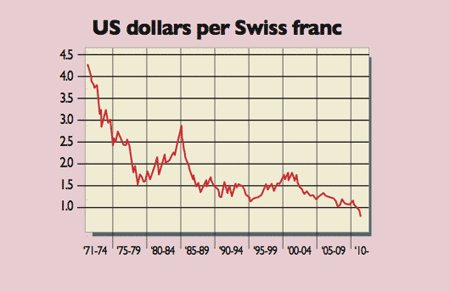
“With resolution to the debt ceiling debate uncertain, the risks are to risky assets more than Treasuries and ratings,” argued Morgan Stanley analysts, writing before Congress passed a compromise to lift the ceiling. But while it’s impossible to know what would have happened had America not reached a deal in time, action in the markets lately has been inconsistent when it comes to risk.
“All week, the pressure in financial markets has been reflected by the pummelling suffered by risky assets and the dollar, but not by the Treasury market,” says Michael Mackenzie in the Financial Times. “True, yields on short-term Treasury bills that mature in August have risen sixfold to 0.3%, a sign some investors fear they will not be paid in full this week.” But longer maturities showed, if anything, the usual move into American government bonds as a safe haven, with the yield on ten-year Treasuries moving below 2.9%.
Meanwhile, the dollar weakened against the Japanese yen and the Swiss franc, “the new reserve currency for the discerning investor”, as Charlie Parker put it on Citywire. The greenback’s “weakness compared to the Swiss franc is extraordinary”; the dollar hit a new record low below $0.77 per franc. “Gold is now arguably seen as a safer short-term park for cash than US Treasuries” as the metal price hit a new nominal high.
However, the picture elsewhere was less clear. The US dollar strengthened against sterling and the Australian dollar, which are presumably considered even less safe than America. But what to make of the fact that the dollar is now below 8,500 Indonesian rupiah, its weakest since 2004? A rush into safe havens is supposed to be accompanied by a rush out of emerging markets (EMs).
That said, risk and EMs have had an unusual relationship all year, says Bhanu Baweja of investment bank UBS. “If risk is a problem for EM, someone forgot to tell bond investors.” Flows into EM debt have been good in the first half of the year even while EM equities have been underperforming developed ones. Yields are steady and EM credit default swaps have fallen, “despite the steady worsening in global investor risk appetite”. It would be dangerous to conclude that EMs can shrug off the rest of the world’s troubles, Baweja adds. But something rather odd is going on in investors’ views of risk.